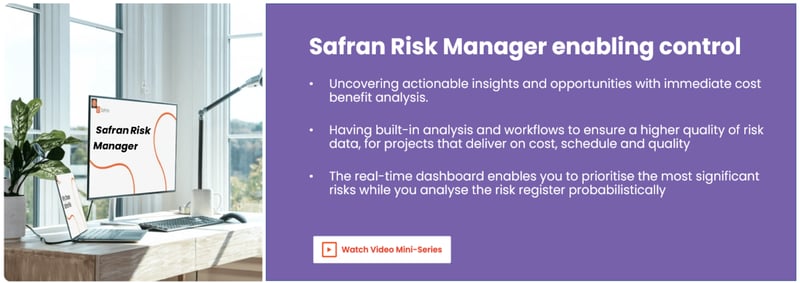How To Enhance Visibility and Data Insights In Project Risk Management?
Welcome to the second instalment of our four-part series, where we continue to explore the powerful impact of transforming an organisation's approach to risk management. In this exploration, we delve deeper into the transformative influence of strategic changes in risk management practices on an organisation's culture and the tangible value it delivers.
Introduction
In today's dynamic business environment, gaining comprehensive risk data visibility is crucial for effective risk management. Traditional methods often fall short, with challenges in obtaining accurate insights and making informed decisions difficult to achieve. However, organisations can enhance visibility and leverage valuable data for improved project outcomes by implementing a risk management tool like Safran Risk Manager.
Breaking Data Silos
Organisations need to transform their risk management practices in today's rapidly evolving business landscape. Data silos hinder collaboration, impede risk management efforts, and limit the ability to make informed decisions. The time has come for a paradigm shift that breaks down these barriers and embraces a proactive, data-driven approach to risk management. By harnessing the power of technology and adopting innovative strategies, organisations can revolutionise their risk management practices and pave the way for success.
Data silos pose a significant challenge to effective risk management. When risk information is scattered across different projects and departments, it becomes difficult to understand the risks at hand comprehensively. However, by centralising risk information through advanced risk management tools, organisations can break down these silos and create a unified view. This enables seamless collaboration, fosters cross-functional cooperation, and empowers teams to tackle risks collectively. The breaking of silos enhances collaboration and allows for a holistic approach to risk management.
The dynamic nature of risk requires organisations to have real-time insights to promptly identify and address emerging threats. Traditional methods often fall short, providing outdated and stagnant information. In contrast, advanced risk management tools offer real-time updates and powerful data visualisation capabilities. Through dynamic visual representations of risk landscapes, teams gain immediate insights into potential risks, enabling agile risk management. Real-time insights empower organisations to identify trends, adapt strategies, and respond swiftly to mitigate risks. In today's rapidly changing business environment, real-time insights are no longer a luxury but a necessity.
Empowered Decision Making
In the ever-evolving business landscape, decision-makers face the critical task of navigating risks to ensure the success and sustainability of their organisations. The urgency to transform risk management practices has become evident as organisations strive to break down data silos, embrace real-time insights, and make data-driven decisions. By adopting advanced risk management tools and innovative strategies, organisations can unlock the full potential of their risk management efforts and stay ahead of the competition in today's complex business environment.
One powerful tool that enables this transformation is Safran Risk Manager. Through its implementation, organisations experience a cultural shift in decision-making processes. Decision makers gain access to accurate and timely risk data, providing them with the necessary information to make informed choices confidently. The availability of reliable data fosters a culture of data-driven decision making, where decisions are based on evidence and analysis rather than intuition alone.
This shift towards data-driven decision making has profound implications for organisations. Firstly, it promotes collaboration among project teams. With access to consistent and comprehensive risk data, decision-makers can engage team members in meaningful discussions, encourage diverse perspectives, and drive consensus on risk treatment strategies. This collaborative approach ensures that decisions are well-informed, leveraging the collective expertise and insights of the team.
Secondly, data-driven decision-making fosters transparency and accountability. By relying on reliable risk data, decision makers can communicate the rationale behind their decisions, promoting organisational transparency. This transparency builds trust among team members and stakeholders, as they understand that decisions are not arbitrary but based on objective data and analysis. Furthermore, decision-makers are held accountable for the outcomes of their decisions, as the data-driven approach allows for traceability and evaluation of the effectiveness of risk treatment strategies.
Ultimately, this cultural shift towards data-driven decision making leads to improved project outcomes and business performance. By basing decisions on accurate and timely risk data, organisations can identify and mitigate risks more effectively, reducing the likelihood of costly disruptions and failures. This proactive approach enhances project success rates, improves resource allocation, and ultimately contributes to the organisation's overall performance and success.
Conclusion
In conclusion, transforming risk management practices in today's dynamic business environment has become increasingly urgent. By breaking down data silos, embracing real-time insights, and making data-driven decisions, organisations can navigate risks with confidence and secure a prosperous future.
The implementation of advanced risk management tools, such as Safran Risk Manager, fosters a cultural shift in decision-making processes.
Decision makers gain access to accurate and timely risk data, enabling them to make informed choices based on evidence and analysis. This shift towards data-driven decision making promotes collaboration, transparency, and accountability within project teams, leading to improved project outcomes and overall business performance.
What's next?
In the third article of this series, we delve deeper into the impact of implementing a risk management tool on organisational culture. The tool facilitates consistency and uniformity in risk management practices across the organisation by providing a centralised database and standardised templates for data entry. This standardised approach fosters a sense of ownership and shared responsibility among team members, breaking down silos and promoting collaboration. The tool's user-friendly interface and automated features simplify the identification and assessment of risk data, empowering risk owners to actively engage in the risk management process. As a result, a cultural shift occurs, with risk management becoming ingrained in the organisation's DNA, transcending individual roles and responsibilities.
Would you like to learn more about Safran Risk Manager? Click on the link Here.




